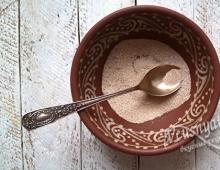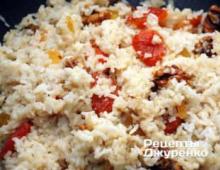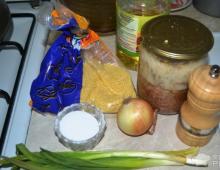How to make salted caviar less salty. How to fix red caviar. Master Class. What to do with excess salt in caviar
Not long ago I encountered a problem - my husband bought caviar, and not only did it turn out to be over-salted, it also had a mediocre taste, the caviar was crushed... In general, half a kilo, it’s a pity to throw it away, there’s no desire. I began to think about how to correct the situation, I heard that it could be washed, but how, what? After a short search, I found an acceptable way, I decided - I’ll take the risk, if it doesn’t work out, then “into the furnace!” I did everything according to the instructions, the result simply shocked me! The taste has improved, the excess salt has gone, and most importantly, caviar to caviar!
I understood how unscrupulous manufacturers and marketers can improve the appearance and taste of a product, so that it would never even cross my mind to doubt its quality. In short, I propose a proven, “tested on dogs” method of correcting red caviar, in case it comes in handy.
Red caviar is a favorite delicacy on holiday tables. It is not only very tasty, but also healthy. Good, high-quality caviar should consist of large eggs of the same size and color, which do not stick together, easily crumble and burst easily on the teeth. It should be thick and smell good. But what to do if the caviar you get is a little stale, has a foreign smell, or is simply too salty? Since the product is quite expensive, it’s a shame to throw it away. You can try to revive the caviar.
You will need:
- water,
- welding,
- gauze,
- two deep containers.
If the caviar is over-salted, then this is an easily fixable problem! You can make it tasty by washing it as follows. Place the caviar in a deep bowl. Fill it with warm boiled water ( not hotter than 35 degrees) at the rate of 2 parts water to one part caviar. Gently stir in the water for 3-4 minutes so that unnecessary salt goes into the water. Pour the caviar and water to strain through cheesecloth or a fine sieve over a sink or saucepan. Leave on a sieve or gauze for 10 minutes to drain off any unnecessary liquid. Place the caviar in a vase or saucer. It is ready to eat.
Caviar that has a foreign odor can be removed. Brew strong tea leaves in any container. Strain the brewed liquid, separating it from the tea leaves. The tea leaves are not needed, throw them away. The brewing temperature should be no more than 30-35 degrees so that the caviar simply does not cook in it. Pour the strained tea over the caviar at the rate of one part caviar to one part brewed tea, or one part caviar to two parts tea, depending on how strong the smell is.
Rinse in the tea leaves for 5-7 minutes, stirring gently so that the eggs do not burst. Strain the caviar through cheesecloth or a sieve and let it drain. Taste it. If you have washed it enough, you can serve it. If the caviar is still salted, repeat the washing procedure.
Do not rinse caviar with fresh cold water! It will become tough and tasteless. Also, do not wash it in very hot water; the caviar will turn whitish, as the protein in the eggs will coagulate.
To remove excess salt from red caviar, you do not need to wash it in water. And the idea of soaking caviar, like a herring, in milk, can only be a nightmare for a person who understands the principles of cooking.
If caviar is too salty, this does not mean that it was deliberately over-salted, because it was of poor quality to begin with. Maybe they just over-salted it when salting it.
If this is the case, then briefly washing the eggs in cold water will not remove excess salt - it is firmly absorbed into each egg. And the more you wash the caviar with water, the more beneficial substances will be washed out of the caviar. In addition, caviar will absorb water, which will not definitely improve its taste - it’s better to eat it salted on bread and butter.
However, there is one good way to remove excess salt from caviar. Transfer the caviar to plastic and place in the freezer for a week. During this time, the salt crystallizes onto the surface of the eggs. Now defrost the caviar in the plus chamber of the refrigerator, place it in a glass container and fill it so that just the surface is covered with medium-strength tea without sugar (make sure there are no tea leaves) and mix well. After ten minutes, drain the tea - the caviar will become lightly salted - all the excess salt will leave the caviar.
There is another method that was used in Soviet restaurants, although not for the purpose of removing excess salt from caviar, but for a completely different purpose.
Transfer the caviar into a glass container and add one to one (or slightly less) volume of freshly opened beer. Stir with a spoon until the beer is completely absorbed into the caviar. The caviar will become larger, softer and tastier. Salt is compensated almost twice.
There are probably no other good ways to remove excess salt from caviar.
★★★★★★★★★★
Comments
I can hardly imagine how caviar can be washed in water (like buckwheat or what?) or soaked in milk)) Probably, you can throw it away immediately.
Caviar, eggs are fat and protein. It is impossible to wash anything out of fat. Probably the cold is the best helper in this case.
I wonder if sugar will help? The salty taste is sometimes corrected with sugar.
It’s even better to freeze, defrost (certainly the quality and beneficial properties will increase), and then still rinse in tea/beer... Apparently, both a drink and a snack at once..
It’s better, of course, not to do any soaking/rinsing/freezing... this won’t add to the quality. But the question is asked - how to remove salt? We have to find ways out...
In mineral water, at least, people do and seem to do nothing, eat. Friends shared this method; they often receive caviar from the Far East..
Perhaps someone soaks it in beer. People do weird things in different ways. And that is also a method that has a right to exist...
Restaurants used to use Moscow mineral water for black caviar and beer for red caviar to generate unearned income. Unlike some consultants (I don’t specify personally in order to avoid violating the rules of the site), I write only about what I know. Now about the freezer. Caviar is a perishable product. It is transported frozen. I also know this absolutely for sure. If caviar is not stored in the freezer, then it contains preservatives. As for adding granulated sugar to salted caviar, it won’t work - it won’t dissolve in the caviar and will grate on your teeth.
To remove excess salt from red caviar, you do not need to wash it in water. And the idea of soaking caviar, like a herring, in milk, can only be a nightmare for a person who understands the principles of cooking.
If caviar is too salty, this does not mean that it was deliberately over-salted, because it was of poor quality to begin with. Maybe they just over-salted it when salting it.
If this is the case, then briefly washing the eggs in cold water will not remove excess salt - it is firmly absorbed into each egg. And the more you wash the caviar with water, the more beneficial substances will be washed out of the caviar. In addition, caviar will absorb water, which will not definitely improve its taste - it’s better to eat it salted on bread and butter.
However, there is one good way to remove excess salt from caviar. Transfer the caviar to plastic and place in the freezer for a week. During this time, the salt crystallizes onto the surface of the eggs. Now defrost the caviar in the plus chamber of the refrigerator, place it in a glass container and fill it so that just the surface is covered with medium-strength tea without sugar (make sure there are no tea leaves) and mix well. After ten minutes, drain the tea - the caviar will become lightly salted - all the excess salt will leave the caviar.
There is another method that was used in Soviet restaurants, although not for the purpose of removing excess salt from caviar, but for a completely different purpose.
Transfer the caviar into a glass container and add one to one (or slightly less) volume of freshly opened beer. Stir with a spoon until the beer is completely absorbed into the caviar. The caviar will become larger, softer and tastier. Salt is compensated almost twice.
There are probably no other good ways to remove excess salt from caviar.
★★★★★★★★★★
Comments
I can hardly imagine how caviar can be washed in water (like buckwheat or what?) or soaked in milk)) Probably, you can throw it away immediately.
Caviar, eggs are fat and protein. It is impossible to wash anything out of fat. Probably the cold is the best helper in this case.
I wonder if sugar will help? The salty taste is sometimes corrected with sugar.
It’s even better to freeze, defrost (certainly the quality and beneficial properties will increase), and then still rinse in tea/beer... Apparently, both a drink and a snack at once..
It’s better, of course, not to do any soaking/rinsing/freezing... this won’t add to the quality. But the question is asked - how to remove salt? We have to find ways out...
In mineral water, at least, people do and seem to do nothing, eat. Friends shared this method; they often receive caviar from the Far East..
Perhaps someone soaks it in beer. People do weird things in different ways. And that is also a method that has a right to exist...
Restaurants used to use Moscow mineral water for black caviar and beer for red caviar to generate unearned income. Unlike some consultants (I don’t specify personally in order to avoid violating the rules of the site), I write only about what I know. Now about the freezer. Caviar is a perishable product. It is transported frozen. I also know this absolutely for sure. If caviar is not stored in the freezer, then it contains preservatives. As for adding granulated sugar to salted caviar, it won’t work - it won’t dissolve in the caviar and will grate on your teeth.
Sturgeon and salmon caviar, black and red, is one of the favorite delicacies. Black caviar was not always like this, because... The origins of sturgeon fishing go back to the time of Ivan the Terrible, so there was plenty of it until the beginning of the twentieth century. Salmon or red caviar is a completely different matter. It has always been considered a delicacy, because the Far East was annexed to Russia relatively recently. At the beginning of the last century, the Japanese were the first to begin preparing red caviar, and then the Russians invented their own method of salting.
Red caviar: how to wash off the salt
Photo by Shutterstock
Red and black caviar contain potassium, calcium, magnesium, vitamins A, C, and group B. This is not accidental; nature itself has placed all the nutritional components in the “fish eggs” so that they are sufficient for the development of large and strong fish. Part of this set of nutrients is of great value to the human body.
High-quality caviar consists of large eggs of the same color and size that burst in the mouth. When purchasing a delicacy, it is better to opt for caviar packaged in glass containers, because... she is clearly visible. If you happen to purchase low-quality caviar that has a foreign smell, looks stale, or is very salty, you can wash it.
How to get rid of excess salt
Excess salt from caviar is washed off well. To do this, place over-salted caviar in a deep container and fill it with warm boiled water (below 35°C); there should be exactly 2 times more of it than caviar. Gently stir the eggs for 3-4 minutes. During this time, the salt will dissolve. Then drain the water through a sieve or cheesecloth over a sink or deep pan and leave for 10 minutes to drain all the remaining liquid. The caviar will not be too salty.
How to remove foreign odor
In order to get rid of the bad smell, you need to make a strong brew. Then strain it through a sieve, separating it from the tea leaves. Throw away the tea leaves; they won't be needed. Cool the brew to room temperature.
To prevent the eggs from boiling, the brewing temperature should not exceed 35°C
Pour the prepared tea leaves over the caviar at the rate of 1 part caviar to 1 part tea leaves. If the smell is strong, it is necessary to double the amount of tea leaves, i.e. 2 parts tea leaves to 1 part caviar.
Leave the caviar in the liquid for 5–7 minutes, stirring it gently so that the eggs do not burst. Strain the caviar through a sieve or cheesecloth and leave for a while, allowing the remaining liquid to drain.
How to make caviar look beautiful
When purchasing caviar, you should always pay attention to its appearance. Sometimes this turns out to be impossible, because... many manufacturers pack it in cans. If it happens that you bought caviar that looks stale, you can try to correct such a defect.
To do this, you need to heat the pasteurized milk to 40°C. Boil village milk and cool to the same temperature. Rinse the caviar for 10 minutes. Place in a sieve or drain the milk through cheesecloth and leave for a few minutes to remove excess liquid. The delicacy will look beautiful.
Under no circumstances should you wash caviar with cold fresh water, as this will make it tasteless and hard. And from hot water, the eggs will take on a whitish tint due to the fact that the protein will coagulate in them.


